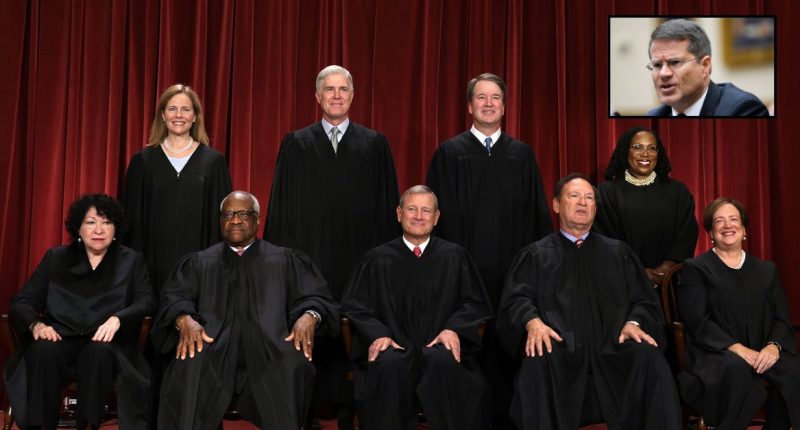Share this @internewscast.com
The background features an image taken on October 7, 2022, at the United States Supreme Court in Washington, DC. Present are Associate Justices Sonia Sotomayor, Clarence Thomas, Samuel Alito, Elena Kagan, and Chief Justice John Roberts in the front row, with Associate Justices Amy Coney Barrett, Neil Gorsuch, Brett Kavanaugh, and Ketanji Brown Jackson in the back row. This official portrait was captured in the Supreme Court’s East Conference Room by Alex Wong/Getty Images. Additionally, on July 20, 2023, D. John Sauer, a Special Assistant Attorney General from Louisiana, is seen testifying during a House Judiciary subcommittee session concerning alleged politicization of the FBI and Justice Department, along with threats to American civil liberties. This inset is provided by AP Photo/Patrick Semansky.
The Trump administration has sought intervention from the Supreme Court to reinstate its initiative for mass dismissals of federal employees, which a California federal judge had previously suspended nationwide.
On Friday, Solicitor General D. John Sauer filed a request with the justices to lift the temporary restraining order issued by U.S. District Judge Susan Illston on May 9. Judge Illston had halted the Trump administration’s execution of an executive order by President Donald Trump dated February 11. This order, named “Implementing The President’s ‘Department Of Government Efficiency’ Workforce Optimization Initiative,” was created to spearhead a “significant transformation of the Federal bureaucracy” aiming to “reduce waste, excess, and insularity.” The legal challenge was mounted by a coalition of labor unions, nonprofit organizations, and municipalities.
Illston, a Bill Clinton appointee, expressed severe misgivings with how the Trump administration tried to achieve its aims, noting that the order tasked three agencies and offices — the Office of Personnel Management (OPM), the Office of Management and Budget (OMB), and the Department of Government Efficiency (DOGE) — with most of the heavy lifting.
Love true crime? Sign up for our newsletter, The Law&Crime Docket, to get the latest real-life crime stories delivered right to your inbox.
Illston found that neither OPM nor OMB have any statutory authority to terminate employees — aside from their own internal employees — “or to order other agencies to downsize” or to restructure other agencies. And, as far as the Elon Musk-led DOGE is concerned, the judge found that, “[a]s plaintiffs rightly note, DOGE ‘has no statutory authority at all.””
Illston also ordered the administration to comply with the plaintiffs’ discovery requests, although she subsequently temporarily stayed that particular directive.
In his plea, Sauer compared President Donald Trump’s Reduction in Force (RIF) efforts to those of a longtime conservative punching bag: President Bill Clinton.
“The Executive has repeatedly exercised RIF authority,” Sauer wrote. “In 1993, for example, President Clinton ordered all federal agencies with more than 100 employees to ‘eliminate not less than 4 percent of [their] civilian personnel positions’ within three years.”
Sauer called Illston’s determination that “the President may not, without Congress, fundamentally reorganize the federal agencies” meritless — and assures the justices that Trump’s directive actually requires that agencies stick to the law.
“The Executive Order makes clear that, in proposing RIFs, agencies should ensure that they do not eliminate any ‘subcomponents’ that are ‘statutorily required’ or prevent the performance of ‘functions’ that are ‘mandated by statute or other law,’ and the Memo reaffirms that ‘[a]gencies should review their statutory authority and ensure that their plans and actions are consistent with such authority,’” Sauer wrote. “There is no coherent reason why the President needs statutory authorization to direct agencies to conduct RIFs to further a reorganization within the statutory bounds permitted by Congress, let alone when it is undisputed that the agencies could have done the exact same thing unilaterally.”
Sauer accused Illston of “join[ing] the parade of courts entering improper universal injunctions, extending relief far beyond what was necessary to redress respondents’ alleged injuries.”
That “abuse of equitable power alone calls for a stay,” Sauer wrote, adding that a “district-court order broadly barring almost the entire Executive Branch from acting to manage the size of its workforce gravely hinders governmental interests of a high order.”
The district judge’s own awareness that her order may encompass those not involved in the case also supports its revocation, Sauer said.
“The court openly acknowledged that its order would ‘provide relief beyond the named parties,’ but it claimed that ‘to do otherwise is impracticable and unworkable, particularly where the agencies’ RIF plans largely remain secret,’” the filing said. “But that approach gets things entirely backwards: It is respondents’ burden, not the government’s, to justify the scope of the injunctive relief sought and identify those parties that actually face imminent harm absent such relief; and it is up to the government, not the district court, to determine whether complying with a properly limited injunction is sufficiently unworkable that it should choose to extend broader relief to make it easier to comply.”
In pushing for the justices to take the case now, Sauer argued that the matter presents questions that the Supreme Court would have to face anyway.
“This Court has repeatedly intervened — both recently and historically — in cases in which lower courts, like the district court here, have attempted to direct the functioning of the Executive Branch — let alone on the global scale at issue here,” Sauer wrote.
“The district court’s novel imposition of limits on the President’s ability to control executive agencies in exercising their power over personnel is the same type of important question of federal law that warrants this Court’s review,” he later added.
The injury to the government, Sauer argues, far outstrips any stated injury to the plaintiffs, who “can seek reinstatement and backpay through the proper channels” if they are caught up in the RIFs.
Sauer additionally asked the Supreme Court to put a stay on Illston’s May 9 order even as the court considers whether to take the case, putting the blame for an inefficient government squarely on the justices’ shoulders.
“Every day that the district court’s order remains in effect, a governmentwide program to implement agency RIFs is being halted and delayed, maintaining a bloated and inefficient workforce while wasting countless taxpayer dollars,” Sauer wrote.
As Law&Crime has previously reported, Sauer was before the justices on Thursday arguing against the general validity of nationwide injunctions issued by a federal district court. The Trump administration maintains that a federal court order issued in one circuit should not have the power to bind the other circuits, or chaos and judicial overreach will reign. During that hearing, multiple justices seemed skeptical of Sauer’s argument, including Trump appointee Amy Coney Barrett, sparked the ire of the president’s supporters when she challenged Sauer’s assertion that it was the administration’s “general practice” to respect precedents, but it was “not a categorical practice.”
















